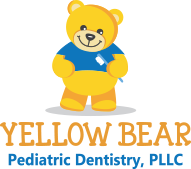FAQs
A pediatric dentist takes two additional years of specialized training that focuses on children. This gives pediatric dentists the skills they need to build strong and trusting relationships with children from infants to young adults and an understanding of their unique dental health needs.
Your child should visit the dentist by his or her first birthday or by the time their first tooth erupts. This way any developing problems can be detected, treated early, or avoided all together. Be sure to inform your child of the visit and its purpose, but take care in how you present it. Avoid using words that cause fear such as “needle”, “pull”, “drill”, or “hurt.” The first visit rarely requires such things, and, even should they be necessary at some point, keep in mind that pediatric dentists are trained to convey the information in a non-threatening way, helping to keep your child calm and comfortable.
Healthy primary teeth are important for many reasons:
- They facilitate proper chewing enabling good nutrition and hold space for the developing permanent teeth to erupt in proper position.
- We are often asked, “Why put fillings in baby teeth when they will fall out anyway?” Unfortunately, neglected cavities continue to grow in size. These cavities can then progress to the core of the tooth and can cause damage to the nerve of the tooth. This can result in pain and/or swelling for your child. Some severe cases require emergency hospitalization.
- The primary teeth in the front or anterior of your child will be lost around 5-8 years of age but the back molars are not lost until 10-13 years of age. Your child has these teeth for a long time so it is important to take care of them
- Brown or missing teeth often affect the development of self-esteem. A beautiful smile enhances self confidence regardless of age.
Also known as Early Childhood Caries or Nursing Caries, Baby Bottle Tooth Decay is caused by over exposure to sugary liquids. It is usually caused by putting a baby to bed with a bottle containing milk, juice, or soda, nursing babies on demand throughout the night, or allowing toddlers to graze with a sippy cup. This condition often destroys primary teeth, creating a need for major dental treatment. In addition, it will eventually damage your child’s permanent teeth if left untreated.
You can prevent this by following a few simple guidelines:
- Never allow your child to fall asleep with a bottle containing milk, formula, breast milk, fruit juices, or any sweetened liquids.
- Never give your baby a pacifier dipped in sugar or honey.
- Only allow water in bottles and sippy cups used for grazing.
- Wipe your baby’s gums with a clean gauze pad after each feeding, and begin brushing with a Fluoride free toothpaste as soon as the first tooth appears.
- Encourage children to drink from a regular cup by their first birthday.
Thumb sucking is normal for infants and most negative effects on their dentition will be reversed as long as your child stops the habit before his/her third birthday. Thumb sucking if continued could lead to severe bite problems as your child gets older. If given the option we recommend giving your child the pacifier rather than allowing him/her to suck their thumb as this habit can be stopped much easier once the parent and child are ready.
Brushing your teeth effectively removes plaque and food particles from tooth surfaces, but can’t properly clean the hard-to-reach areas between them. This leaves these areas highly susceptible to decay and periodontal disease (gum disease). Daily flossing corrects this problem by cleaning between the teeth and under the gum line, disrupting the build up of plaque colonies and helping to prevent damage to the gums, teeth, and bone.
Plaque is an invisible film of living bacteria combined with food debris and saliva. It produces the toxins that cause cavities and irritate the gums. When left in place, it hardens and turns into tartar (known as calculus) which further irritates and inflames the gums while slowly eating away at the dental bone structure, marking the beginning of periodontal disease.
How to floss properly:
- Take 12-16 inches (30-40cm) of dental floss and wrap it around your middle fingers, leaving about 2 inches (5cm) of floss free between them.
- Using the thumbs and forefingers to guide the floss, gently insert it between the teeth and slide it back and forth in a sawing motion.
- Curve the floss into a “C” shape around each tooth and under the gum line. Gently move the floss up and down, cleaning the side of each tooth.
- For those who might struggle with this process, we recommend floss holders.
First, check with your physician regarding allergies to pain medications. Then, rinse the irritated area with warm salt water and place a cold compress on your child’s face if it is swollen. You can give acetaminophen for pain, but avoid placing aspirin directly on the teeth or gums. Please call our office immediately
Use a soft-bristled toothbrush with a small head at twice a day. There are toothbrushes are specifically designed for both infants and young children.
